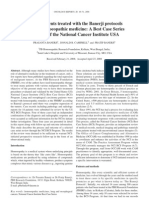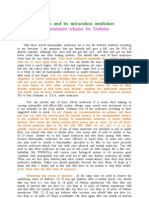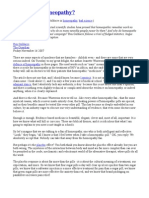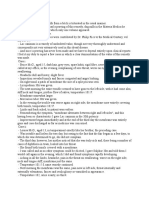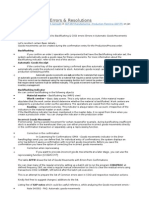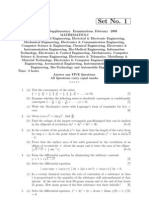Banerji Chron Hepatitis
Banerji Chron Hepatitis
Uploaded by
daspranabCopyright:
Available Formats
Banerji Chron Hepatitis
Banerji Chron Hepatitis
Uploaded by
daspranabOriginal Description:
Copyright
Available Formats
Share this document
Did you find this document useful?
Is this content inappropriate?
Copyright:
Available Formats
Banerji Chron Hepatitis
Banerji Chron Hepatitis
Uploaded by
daspranabCopyright:
Available Formats
24 Volume 1, Number 1 March 2012 www.gahmj.
com
GLOBAL ADVANCES IN HEALTH AND MEDICINE
Case Report
CASE REPORT
Successful Treatment of Chronic Viral Hepatitis With
High-dilution Medicine
Barbara Sarter, PhD, APRN, FNP-C, DiHom; Prasanta Banerji, FMIH; Pratip Banerji, MD(Hom)
Author Affiliations
Barbara Sarter, PhD,
APRN, FNP-C, DiHom, is
an associate professor at
Hahn School of Nursing
and Health Sciences,
University of San Diego,
California. Prasanta
Banerji, FMIH, is managing
trustee and Pratip Banerji,
MD(Hom), is deputy
managing trustee at PBH
Research Foundation,
Kolkata, India.
Correspondence
Prasanta Banerji, FMIH
info@pbhrfindia.org
Citation
Global Adv Health Med.
2012;1(1):24-27.
Key Words
Viral hepatitis,
ultradilute medicines,
homeopathy, liver disease,
case reports, India
ABSTRACT
Introduction: Two cases of viral
hepatitis that had failed convention-
al therapy are presented. Both were
subsequently treated with protocols
using homeopathic medicines as
detailed below. Both patients sus-
tained remissions for 2 years afer
taking ultradilute natural medicines
afer their conventional treatment
had been discontinued.
Methods: The treatment protocol
included Chelidonium majus 6X and
Thuja 30C as the main medicines.
Other homeopathic medicines were
used as detailed below. Cases were
conrmed with standard hepatitis
antibody and viral measurements.
Patients were followed for more than
2 years with measurements of viral
counts, liver enzymes, and other rel-
evant biomarkers of liver disease.
Results: Both patients are alive and
functioning normally in their home
environments more than 2 years
afer treatment initiation.
Discussion: We review the litera-
ture related to the chief medicines
used in these cases and nd that they
have known and demonstrated ther-
apeutic efects suggesting plausible
mechanisms of action in these cases.
Conclusions: Clinical trials of this
homeopathic treatment protocol
should be conducted to explore the
therapeutic potential of these medi-
cines for treatment of viral hepatitis.
|
{.;|,)5)[|]
j]j]|])
|j,),||,)+
+[;|,)}|
j[[;|)|
({j?+[|
)
,.)b\130C
7,)[|)|
,),|[|j+
|(]j|1]
,|]][,)|]
].]
`,][)||||
|{|]?+[)
[
;.+),)?+)|
({j+]]+|[
;
).]|]|j[
|[|[|
|)|)|[.|
j|[)}{[
|[|+]
|||j
;.,,,),|[
,,||
j]j[,+)
RESUMEN
Introduccin: Se presentan dos casos
de hepatitis viral en los cuales la terapia
convencional no fue efectiva. Ambos
fueron tratados posteriormente segn
protocolos de uso de medicamentos
homeopticos, como se describe a con-
tinuacin. Ambos pacientes registraron
una remisin sostenida durante 2 aos,
luego de consumir medicamentos natu-
rales ultradiluidos y de que se descon-
tinuaran sus correspondientes trata-
mientos convencionales.
Mtodos: El protocolo de tratamiento
incluy como medicamentos princi-
pales Chelidonium majus (Celidonia
mayor) 6X y Thuja (Tuya) 30C. Se uti-
lizaron otros medicamentos homeopti-
cos, como se indica a continuacin. Se
conrmaron casos de desarrollo de anti-
cuerpos estndares contra la hepatitis y
mediciones de carga viral. Se realiz un
seguimiento de los pacientes durante
ms de 2 aos con mediciones de carga
viral, enzimas hepticas y otros marca-
dores biolgicos relevantes de enferme-
dades hepticas.
Resultados: Ambos pacientes viven y
se desenvuelven normalmente en sus
hogares, luego de transcurridos ms de
2 aos desde el inicio del tratamiento.
Discusin: Analizamos la informacin
relacionada con los medicamentos
principales empleados en estos casos y
descubrimos que tienen efectos tera-
puticos conocidos y demostrados que
sugeran mecanismos de accin convin-
centes aplicables a estos casos.
Conclusiones: Los ensayos clnicos
de este protocolo de tratamiento
homeoptico se deben llevar a cabo
para analizar los efectos teraputicos
potenciales de este tipo de medica-
mentos para el tratamiento de la hep-
atitis viral.
www.gahmj.com Volume 1, Number 1 March 2012 25
U
ltradilute, serially agitated solutions behave
quite differently than normal solutions; the
principles of their behavior are being actively
researched around the world.
1
Meanwhile, ultradilute
solutions in the form of homeopathic medicines are
widely sought and used clinically throughout the
world. In 1999, the US National Cancer Institutes
Office of Cancer Complementary and Alternative
Medicines rigorous Best Case Series validated the
effectiveness of cancer treatment protocols in 14 cases
of different varieties of the disease using homeopathic
medicinal protocols developed at the Prasanta Banerji
Homeopathic Research Foundation (PBHRF) in
Kolkata, India, and identified studies in collaboration
with PBHRF as a funding priority.
2
Published research
reports also provide credible evidence of the mecha-
nisms of action and effectiveness of some of the proto-
cols used at PBHRF to treat cancer.
3-7
In addition to cancer, virtually all diseases are treated
at PBHRF with specific protocols using ultradilute medi-
cines. In this article, we report on 2 well-documented
cases of progressively worsening acute and chronic viral
hepatitis that responded to treatment with these medi-
cines per the Banerji Protocol.
CASE 1
On a routine health maintenance visit in 1994, a
37-year-old woman was found to have elevated liver
enzymes. Her first liver biopsy in January 1998 showed
grade 1 (of 4) inflammation and stage 1 to 2 (of 4) delicate
bridging fibrosis. Subsequent hepatitis C antibody test-
ing revealed chronic hepatitis C. Genotyping of the virus
in 1998 revealed type 1b with a viral count of 33000000
IU/mL. She enrolled in a clinical trial of pegylated inter-
feron (PEG-INF) subcutaneously 1.5 g/kg once a week
for 4 weeks followed by PEG-INF 0.5 g/kg once a week
for 44 weeks along with ribavirin 1000 mg orally daily,
which was reduced to 600 mg daily due to anemia at
treatment week 30. Serum levels of alanine aminotrans-
ferase reflected a response with relapse. Her virologic
response using polymerase chain reaction (PCR)based
assay for hepatitis C virus RNA showed a temporary
response. Posttreatment liver biopsy performed 6
months after completing treatment (in July 2000) was
scored as grade 3 of 4 inflammation and stage 1 of 4 fibro-
sis with piecemeal necrosis consistent with relapse. Her
viral count at that time was 16000000 IU/mL. A biopsy
conducted in December 2003 showed inflammation
grade 3 and fibrosis stage 3 of 4. She became increasingly
symptomatic with nausea, fatigue, and loss of appetite.
In April 2004, she started a second course of PEG-INF
with ribavirin after undergoing whole-body hyperther-
mia. After 6 months, she was found to have no response
to the interferon, and the drugs were discontinued. A
biopsy in November 2005 showed stage 3 of 4 fibrosis
and moderate (3 of 4) portal inflammation. Viral count
in July 2006 was 14250000 IU/mL, and the patient was
found to have persistent stage 3 of 4 fibrosis and grade 3
of 4 inflammation with bridging necrosis.
In August 2006, the patient initiated treatment pre-
scribed by the PBHRF. The following protocol was used:
1. Chelidonium 6X twice a day,
2. Thuja 30C twice a day, and
3. Kalium muriaticum 3X and Ferrum phosphoricum
3X twice a day.
The 6X potency is the 6th decimal potency that is
achieved by serial dilution and agitation of the mother
tincture, or alcoholic extract, of the root of the plant
Chelidonium majus. Thuja 30C is likewise the 30th cen-
tesimal serial dilution and agitated product; here, the
alcoholic extract is from the fresh leaves and small twigs
of the young Thuja occidentalis plant. The Kali muriati-
cum 3X and Ferrum phosphoricum 3X are triturations
of the substances to the 3rd decimal potency. The medi-
cine was procured from reputable homeopathic drug
manufacturers and manufactured as per The
Homeopathic Pharmacopoeia of India.
Chelidonium 6X and Thuja 30C are our standard
protocol for cases of chronic viral hepatitis. Chelidonium
has a strong body of research supporting its use for liver
disease, and Thuja is effective in treating a wide variety
of viral infections (see Discussion section). The combina-
tion of Kali muriaticum and Ferrum phosphoricum is
our standard protocol for treatment of anemia, which
this patient experienced as a side effect of interferon/
ribavirin therapy.
The patient adhered to this protocol for 2 years
and was rebiopsied in the United States in December
2008. Her inflammation was reduced to stage 1 of 4,
and her fibrosis had regressed to stage 0-1a of 4. She
used no other treatments during this time period. She
no longer experiences daily nausea and has regained
her normal body weight. Her viral count in December
2009 was 7 IU/mL. As of June 2011, she remained in
remission and continued treatment with Chelidonium
6X twice a day. Table 1 provides a summary of the rel-
evant biomarkers.
CASE 2
In late November 2007, a 28-year-old male was
admitted to the premier Indian medical institution, the
All India Institute of Medical Science (AIIMS) in Delhi,
for a case of hepatitis B virus (HBV)related chronic
ULTRADILUTE MEDICINES FOR VIRAL HEPATITIS
Case Report
TABLE 1 Case 1: Chronic Active Hepatitis C
a
Test Reference Range Date Patient Value
HCV RNA 0-7 IU/mL Jul 2006 14 250 000
Dec 2009 7
Liver biopsy Stage 0 inflammation;
stage 0 fibrosis;
Nov 2005 Stage 3 inflammation;
stage 3 fibrosis;
bridging necrosis
Dec 2008 Stage 1 inflammation;
stage 0-1a fibrosis;
no necrosis
a
Homeopathic treatment initiated August 2006; as of June 2011, patient remained in remission.
Abbreviations: HCV, hepatitis C virus; RNA, ribonucleic acid; PCR, polymerase chain reaction.
26 Volume 1, Number 1 March 2012 www.gahmj.com
GLOBAL ADVANCES IN HEALTH AND MEDICINE
Case Report
liver disease decompensated by acute hepatitis E virus
(HEV) infection. He also had developed spontaneous
bacterial peritonitis. His clinical history included a
rapidly progressing jaundice followed by pedal edema,
ascites, fever, and abdominal tenderness. Viral anti-
body testing revealed a positive Australia antigen (hep-
atitis B surface antigen), negative immunoglobulin M
for hepatitis B core antigen, HBV DNA 1300 copies/mL,
and positive immunoglobulin M antibody for HEV. At
AIIMS, he was treated with intravenous glycyrrhizin
(0.2%) 60 mL daily for 6 weeks, and then the dose was
reduced to 3 times a week. Additionally, he received
daily diuretic treatment with spironolactone/furose-
mide (Lasilactone, Sanofi-Aventis) 50 to 75 mg per day,
20% albumin 100 mL intravenously daily for the first 2
months of hospitalization, cefuroxime axetil (Ceftum,
GlaxoSmithKline) 500 mg twice a day for 4 weeks, and
lamivudine-HBV 100 mg daily.
After 6 weeks of hospitalization and treatment at
AIIMS, the patients serum bilirubin continued to be mark-
edly elevated and alanine transaminase was continuously
75 times normal, indicating failure of conservative treat-
ment. Endoscopy revealed esophageal varices. The cancer
antigen 19-9 and carcinoembryonic antigen were negative.
The patient and his parents were advised of the need for a
liver transplant. They refused to have him placed on the
transplant list, and he was discharged in January 2008 and
returned to Kolkata. After repeated episodes of spontane-
ous bacterial peritonitis requiring multiple hospitaliza-
tions in Kolkata, he developed right hepatic hydrothorax.
At this point, the patient sought treatment at PBHRF.
On first presenting at PBHRF on August 22, 2008, he had
severe ascites, dyspnea without exertion, abdominal pain,
and 4+ pitting edema in the lower extremities. Treatment
was initiated with the following protocol:
1. Chelidonium 6X 3 drops alternating 3 times a day
with
2. Carduus marianus (milk thistle) mother tincture 10
drops,
3. Thuja 30C 2 pills once every evening,
4. Lycopodium clavatum 30C 3 drops 3 times a day, and
5. Belladonna 3C alternating with Carduus marianus
mother tincture every 10 minutes as needed for pain.
In addition to our first-line agent, Chelidonium, we
added Carduus marianus, as it has a long history of use in
traditional herbal medicine for support of liver problems.
Thuja again was prescribed as an antiviral agent.
Lycopodium is our first-line agent for treatment of edema
or fluid retention of any kind. Belladonna is one of our first-
line agents for pain, particularly pain of visceral origin.
When the patients condition did not improve, on
September 15, 2008, Myrica (bayberry) mother tincture
was added, alternating every 3 hours with Chelidonium
6X, and Carduus was discontinued. On September 27,
acetic acid 30C, another of our prime medicines for water
retention and effusions, 3 drops 3 times a day replaced the
Lycopodium for management of the ascites. By December
13, 2008, the patients pleural effusion was clearing, asci-
tes had decreased substantially, and urine output
improved significantly. Clinic notes from January 7, 2009,
reported worsening of the pleural effusion and ascites,
and treatment exclusively by PBHRF continued with the
expectation that improvement was likely to recur. By
March 2009, the patient was reporting a sustained
improvement in symptoms, and the pleural effusion and
ascites had almost completely subsided. On June 3, 2009,
the HBV DNA count was 5.82 copies, and the patient was
feeling well. Blood work done on May 9, 2009, revealed
liver function tests generally near the normal range, as
indicated in Table 2. Table 2 also shows the continued
improvement in liver function tests when retested in
December 2009. As of June 2011, the patient continued to
feel well, having been in remission for 2 years.
DISCUSSION
The protocols used in these cases were developed
based on the extensive experience of the physicians at
PBHRF, which spans several generations, as well as the
known actions of its specific component medicines. We
will briefly review the research literature that is avail-
able on these medicinal substances.
Chelidonium majus (greater celandine) is an herb
with documented hepatotoxic properties in its undilut-
ed tincture or herbal form,
8-10
but it has also been shown
to have hepatoprotective, antitumor, and immunostim-
ulatory actions.
11
Thuja occidentalis has been reported to
have similar hepatoprotective and antitumor
effects.
4,12-17
Thuja and its related species also have been
reported to have antiviral
13,18
and antimetastatic
4
prop-
erties. Myrica, or bayberry, is a common herb that is high
in tannins; there is virtually no research documenting its
effectiveness in treatment of liver disease, but standard
Table 2 Case 2: Hepatitis B Virus and Hepatitis E Virus
a
Test Reference Range Date Patient Value
INR 0.9-1.1 May 2009 1.9
Dec 2009 1.2
tBili <1.0 mg/dL Dec 2007 31.9
May 2009 1.37
Dec 2009 1.21
AST 10-60 IU/L Dec 2007 324
May 2009 65
Dec 2009 36
ALT 10-60 IU/L Dec 2007 241
May 2009 41
Dec2009 25
Alk phos 40-120 IU/L May 2009 275
Dec 2009
GGT 0-60 IU/L May 2009 56
Dec 2009 42
a
Homeopathic treatment initiated August 2008; as of June 2011, the patient remained in remission.
Abbreviations: Alk phos, alkaline phosphatase; ALT, alanine transaminase; AST, aspartate transaminase;
GGT, gamma-glutamyl transferase; INR, international normalized ratio; tBili, total bilirubin.
www.gahmj.com Volume 1, Number 1 March 2012 27
ULTRADILUTE MEDICINES FOR VIRAL HEPATITIS
Case Report
homeopathic references all list jaundice as one of its
principle indications.
19
Carduus marianus (milk thistle)
was reviewed recently in the Cochrane database. The
conclusion of this rigorous review was that
milk thistle could potentially afect alcoholic and/
or hepatitis B or C virus liver diseases. Therefore,
large-scale randomized clinical trials on milk
thistle for alcoholic and/or hepatitis B or C liver
diseases versus placebo are needed.
20
The larger issue is how ultradilute, serially agitated
preparations of these biologically active substances are
able to exert therapeutic effects even when the dilutions
exceed Avogadros number, which is the case for the
dilutions of 30C used in the Banerji Protocol for hepati-
tis. The preparations of Chelidonium are diluted to a
factor of 1/1000000; this explains the lack of toxicity
observed in the normally hepatotoxic Chelidonium
when in its crude form but does not explain its effective-
ness as a hepatoprotectant. The emerging disciplines of
complexity, nanoscience, and materials science offer
some hypotheses on how these ultradilute medicines
may still maintain biological activity.
21
One research
team advocated the hypothesis based on available scien-
tific evidence and logic that one major pathway of ultra-
dilute homeopathic drugs could possibly be through
regulation of expression of relevant genes.
1
A recent
study by Frenkel et al provided solid support for this
hypothesis.
3
The medicines used by PBHRF for treat-
ment of breast cancer were tested in vitro at the
University of Texas MD Anderson Cancer Center,
Houston. The remedies exerted preferential cytotoxic
effects against 2 breast cancer cell lines, causing cell
cycle delay/arrest and apoptosis. The researchers demon-
strated a clear biological activity of the tested natural
products (Phytolacca, Carcinosin, Conium, and Thuja)
when present at ultradiluted doses.
Despite the lack of a proven explanation for how
these ultradilute medicines exert their effects, there is
significant laboratory evidence that highly dilute toxins
can paradoxically protect the very tissues they harm in
macrodoses. There are several reports of liver damage
reversal in mice with ultradilutions of arsenic trioxide
after exposure to toxic doses of the same substance.
5,22
One randomized double-blind placebo-controlled
human study documented favorable improvements in
multiple markers of arsenic toxicity after 2 months of
treatment with a serially agitated dilution (1:100 dilu-
tion 30 times) of arsenic,
23
or the 30th centesimal
potency. A recent review of the in vitro research on seri-
ally diluted and agitated solutions concluded that even
the studies with high methodological standards demon-
strated an effect of these solutions.
24
A number of articles has been published in medi-
cal journals denouncing categorically the use of
homeopathic medicine, claiming that there is no evi-
dence to support any further research into their thera-
peutic effects. Clearly, even in this very brief research
review and in these case reports, there is enough to
suggest that this is an area that should be further
explored. The era of nanomedicine is upon us and
requires a fresh look at medicines that are ultradiluted.
A major advantage of treating disease with ultradilute
solutions is that adverse effects are virtually eliminat-
ed. The case reports in this article will, hopefully,
inspire a fresh interest and further research in this
fascinating and controversial area of therapeutics.
REFERENCES
1. Khuda-Bukhsh AR. Towards understanding molecular mechanisms of action of
homeopathic drugs: an overview. Mol Cell Biochem. 2003 Nov;253(1-2):339-45.
2. Banerji P, Campbell DR, Banerji P. Cancer patients treated with the Banerji proto-
cols utilising homoeopathic medicine: a Best Case Series Program of the National
Cancer Institute USA. Oncol Rep. 2008 Jul;20(1):69-74.
3. Frenkel M, Mishra BM, Sen S, et al. Cytotoxic effects of ultra-diluted remedies on
breast cancer cells. Int J Oncol. 2010 Feb;36(2):395-403.
4. Es S, Kuttan G, Kc P, Kuttan R. Effect of homeopathic medicines on transplanted
tumors in mice. Asian Pac J Cancer Prev. 2007 Jul-Sep;8(3):390-4.
5. Kundu SN, Mitra K, Khuda Bukhsh AR. Efficacy of a potentized homeopathic
drug (Arsenicum-Aalbum-30) in reducing cytotoxic effects produced by arsenic
trioxide in mice: IV. Pathological changes, protein profiles, and content of DNA
and RNA. Complement Ther Med. 2000 Sep;8(3):157-65.
6. MacLaughlin BW, Gutsmuths B, Pretner E, et al. Effects of homeopathic prepara-
tions on human prostate cancer growth in cellular and animal models. Integr
Cancer Ther. 2006 Dec;5(4):362-72.
7. Pathak S, Multani AS, Banerji P, Banerji P. Ruta 6 selectively induces cell death in
brain cancer cells but proliferation in normal peripheral blood lymphocytes: A
novel treatment for human brain cancer. Int J Oncol. 2003 Oct;23(4):975-82.
8. Hardeman E, Van Overbeke L, Ilegems S, Ferrante M. Acute hepatitis induced by
greater celandine (Chelidonium majus). Acta Gastroenterol Belg. 2008 Apr-
Jun;71(2):281-2.
9. Rifai K, Flemming P, Manns MP, Trautwein C. [Severe drug hepatitis caused by
Chelidonium]. Internist (Berl). 2006 Jul;47(7):749-51. German.
10. Stickel F, Pschl G, Seitz HK, Waldherr R, Hahn EG, Schuppan D. Acute hepatitis
induced by Greater Celandine (Chelidonium majus). Scand J Gastroenterol. 2003
May;38(5):565-8.
11. Song JY, Yang HO, Pyo SN, Jung IS, Yi SY, Yun YS.Immunomodulatory activity of
protein-bound polysaccharide extracted from Chelidonium majus. Arch Pharm
Res. 2002 Apr;25(2):158-64.
12. Guleria S, Kumar A, Tiku AK. Chemical composition and fungitoxic activity of
essential oil of Thuja orientalis L. grown in the north-western Himalaya. Z
Naturforsch C. 2008 Mar-Apr;63(3-4):211-4.
13. Hassan HT, Drize NJ, Sadovinkova EYu, et al. TPSg, an anti-human immunodefi-
ciency virus (HIV-1) agent, isolated from the Cupressaceae Thuja occidentale L.
(Arborvitae) enhances in vivo hemopoietic progenitor cells recovery in sublethal-
ly irradiated mice. Immunol Lett. 1996 Apr;50(1-2):119-22.
14. Iwamoto M, Minami T, Tokuda H, Ohtsu H, Tanaka R. Potential antitumor promoting
diterpenoids fromthe stembarkof Thuja standishii. Planta Med. 2003Jan;69(1):69-72.
15. Katoh T, Tanaka R, Takeo M, Nishide K, Node M. A new synthesis of a potent can-
cer chemopreventive agent, 13-oxo-15,16-dinorlabda-8(17),11E-dien-19-oic acid
from trans-communic acid. Chem Pharm Bull (Tokyo). 2002 Dec;50(12):1625-9.
16. Naser B, Lund B, Henneicke-von Zepelin HH, Khler G, Lehmacher W, Scaglione F.
A randomized, double-blind, placebo-controlled, clinical dose-response trial of an
extract of Baptisia, Echinacea and Thuja for the treatment of patients with com-
mon cold. Phytomedicine. 2005 Nov;12(10):715-22.
17. Sunila ES, Kuttan G. A preliminary study on antimetastatic activity of Thuja occi-
dentalis L. in mice model. Immunopharmacol Immunotoxicol. 2006;28(2):269-80.
18. Bodinet C, Mentel R, Wegner U, Lindequist U, Teuscher E, Freudenstein J. Effect of
oral application of an immunomodulating plant extract on Influenza virus type A
infection in mice.Planta Med. 2002 Oct;68(10):896-900.
19. Murphy R. Homeopathic clinical repertory. 3rd ed. Blacksburg (VA): Lotus Health
Institute; 2005.
20. Rambaldi A, Jacobs BP, Gluud C. Milk thistle for alcoholic and/or hepatitis B or C
virus liver diseases. Cochrane Database Syst Rev. 2007 Oct 17;(4):CD003620.
21. Bellavite P, Signorini A, Fisher P. The emerging science of homeopathy: complex-
ity, biodynamics, and nanopharmacology. 2nd ed. Berkeley (CA): North Atlantic
Books; 2002.
22. Datta S, Mallick P, Bukhsh AR.Efficacy of a potentized homoeopathic drug
(Arsenicum Album-30) in reducing genotoxic effects produced by arsenic trioxide in
mice: II. Comparative efficacy of an antibiotic, actinomycin D alone and in combina-
tion with either of two microdoses. Complement Ther Med. 1999 Sep;7(3):156-63.
23. Belon P, Banerjee A, Karmakar SR, et al. Homeopathic remedy for arsenic toxicity?:
Evidence-based findings from a randomized placebo-controlled double blind
human trial. Sci Total Environ. 2007 Oct 1;384(1-3):141-50. Epub 2007 Jul 12.
24. Witt CM, Bluth M, Albrecht H, Weisshuhn TE, Baumgartner S, Willich SN. The in
vitro evidence for an effect of high homeopathic potenciesa systematic review
of the literature. Complement Ther Med. 2007 Jun;15(2):128-38. Epub 2007 Mar 28.
You might also like
- Banerji Protocol Chapter 2Document5 pagesBanerji Protocol Chapter 2Ashok RajGuru60% (5)
- Androctonus Amoreuxii Hebraeus (Jeremy Sherr)Document17 pagesAndroctonus Amoreuxii Hebraeus (Jeremy Sherr)Alexandre Funcia100% (2)
- Homeopathic Drainage Repertory Chapter ADocument45 pagesHomeopathic Drainage Repertory Chapter Aهند أبوزيدNo ratings yet
- Guide To Methodologies 1 PDFDocument83 pagesGuide To Methodologies 1 PDFeminaluna100% (2)
- Nimisha Parekh Narayani Remedies: Reading ExcerptDocument3 pagesNimisha Parekh Narayani Remedies: Reading ExcerptFaomix de la House0% (1)
- Inspiring Homeopathy Final Edition Tinus Smits.11560 1Document57 pagesInspiring Homeopathy Final Edition Tinus Smits.11560 1Adriana Scaglione80% (5)
- Transaxle: NV T350 (A-578) Manual TransaxleDocument120 pagesTransaxle: NV T350 (A-578) Manual TransaxlePelis CloneNo ratings yet
- Banerji Protocol 6Document4 pagesBanerji Protocol 6Sandip ChatterjeeNo ratings yet
- Banerji Protocol 3Document3 pagesBanerji Protocol 3Sandip Chatterjee100% (2)
- Perform in The Storm CD Script 2013Document29 pagesPerform in The Storm CD Script 2013Nadine LeonovaNo ratings yet
- Kushal and Kalyan Banerjee - California Presentation - May 10 Cleaned PDFDocument22 pagesKushal and Kalyan Banerjee - California Presentation - May 10 Cleaned PDFmarkosNo ratings yet
- Homeopathy Cancer Banerji ProtocolsDocument22 pagesHomeopathy Cancer Banerji Protocolsaldodias100% (1)
- Nosodes Sarcodes HomeopathyDocument35 pagesNosodes Sarcodes Homeopathydrdivish100% (1)
- Banerji Protocol 5Document3 pagesBanerji Protocol 5Sandip ChatterjeeNo ratings yet
- Immunotherapy With Banerji ProtocolDocument43 pagesImmunotherapy With Banerji ProtocolSur E JahanNo ratings yet
- A Critical Study On Boenninghausens Therapeutic Pocket BookDocument10 pagesA Critical Study On Boenninghausens Therapeutic Pocket Bookamblingby100% (1)
- 10M Case NotesDocument2 pages10M Case NotesAEMendez541100% (2)
- Bowel Nosodes in Homeopathic Practice: Third EditionDocument23 pagesBowel Nosodes in Homeopathic Practice: Third EditionFuente DelavidaNo ratings yet
- Home o ProphylaxisDocument26 pagesHome o ProphylaxisLokir_leika_vllrNo ratings yet
- Banerji Protocol 4Document6 pagesBanerji Protocol 4Sandip ChatterjeeNo ratings yet
- PBHRF Homeopathy of The 21st CenturyDocument60 pagesPBHRF Homeopathy of The 21st CenturyGeorge MontoyaNo ratings yet
- Final Chapter 6Document34 pagesFinal Chapter 6Tayyab Tahir MinhasNo ratings yet
- Banerji 2008Document6 pagesBanerji 2008angelon777No ratings yet
- Case Analysis According To The Methodology ofDocument32 pagesCase Analysis According To The Methodology ofcesarNo ratings yet
- Homoeopathy and MigraineDocument4 pagesHomoeopathy and MigraineEditor IJTSRD100% (1)
- Covid19 Banerji ProtocolDocument3 pagesCovid19 Banerji ProtocolAga Kiermasz100% (5)
- Pregnancy Ailments and Homeopathy - 2Document4 pagesPregnancy Ailments and Homeopathy - 2Anand GuptaNo ratings yet
- Dental RemediesDocument5 pagesDental Remediessunni (aamil) spiritual healerNo ratings yet
- Use of Indigenous and Other Remedies in Homoeopathy As Home RemediesDocument63 pagesUse of Indigenous and Other Remedies in Homoeopathy As Home RemediesasyabatoolNo ratings yet
- Bowel Nosodes in Homeopathic PracticeDocument1 pageBowel Nosodes in Homeopathic PracticeSohail LatifNo ratings yet
- Bhms HomoeopathyDocument74 pagesBhms Homoeopathyprince19000% (1)
- Bacillinum-Experiences and StudyDocument7 pagesBacillinum-Experiences and Studyssrkm guptaNo ratings yet
- Diabetes and Its Miraculous MedicinesDocument13 pagesDiabetes and Its Miraculous MedicinesBashir Mahmud Ellias50% (2)
- Genetic Code of Homoeopathy: Genes CNS Endocrine Organs Connective Tissue Endoderm EctodermDocument8 pagesGenetic Code of Homoeopathy: Genes CNS Endocrine Organs Connective Tissue Endoderm Ectodermanupamprayag0% (1)
- The End of HomeopathyDocument7 pagesThe End of HomeopathySimon100% (1)
- Rubrics For Children in MurphyDocument18 pagesRubrics For Children in MurphyVirag Patil100% (1)
- Homeo For SeniorsDocument17 pagesHomeo For SeniorsAngela100% (2)
- Homeopathic Treatments For AttentionDocument9 pagesHomeopathic Treatments For Attentioncatatutu100% (1)
- Nat Rum Muriatic UmDocument4 pagesNat Rum Muriatic Umtakne_007100% (2)
- The Basic 18 Remedy Kit Contains The Following 18 Remedies: Aconite: A Plant - Aconitum Napellus (Monks Hood)Document5 pagesThe Basic 18 Remedy Kit Contains The Following 18 Remedies: Aconite: A Plant - Aconitum Napellus (Monks Hood)Suresh Krishnan KNo ratings yet
- Paper On Brain Tumor Data PDFDocument5 pagesPaper On Brain Tumor Data PDFBarbara SarterNo ratings yet
- IncidentsHomeopathic TreatmentDocument47 pagesIncidentsHomeopathic Treatmentmihaipopescu0100% (3)
- HomeopathyDocument46 pagesHomeopathyamitjain2892100% (3)
- The Beginner's Guide To Homeopathy by A. LOCKIE 2000Document44 pagesThe Beginner's Guide To Homeopathy by A. LOCKIE 2000suryaNo ratings yet
- Tuberculinum PDFDocument4 pagesTuberculinum PDFadi swara100% (2)
- How To Study Materia Medica Three LecturesDocument34 pagesHow To Study Materia Medica Three LecturesFrank NavaNo ratings yet
- Collapse - Margaret Lucy Tyler - HomeopathyBooks - in PDFDocument4 pagesCollapse - Margaret Lucy Tyler - HomeopathyBooks - in PDFMd Jahirul IslamNo ratings yet
- Laccaninumcases EHDocument20 pagesLaccaninumcases EHCristinaNo ratings yet
- Are Genetics To Blame? A New, Ef Cient and Labour-Saving Approach To Treat Down Syndrome: A Clinical StudyDocument11 pagesAre Genetics To Blame? A New, Ef Cient and Labour-Saving Approach To Treat Down Syndrome: A Clinical StudySamNo ratings yet
- Ignatia AmaraDocument43 pagesIgnatia AmaraDr pragya joshiNo ratings yet
- Psoriasis and Homeopathy PDFDocument7 pagesPsoriasis and Homeopathy PDFRossana Lumina100% (1)
- Modalities of Four Miasmatic StatesDocument23 pagesModalities of Four Miasmatic Statesvirag.patil100% (1)
- Bowel NosodesDocument23 pagesBowel NosodesRajendraNo ratings yet
- Pocket Guide Homeopathic First Aid for Vaccinosis: With Comparative Materia MedicaFrom EverandPocket Guide Homeopathic First Aid for Vaccinosis: With Comparative Materia MedicaNo ratings yet
- Homeopathy and the "Bacteriological Revolution" 1880-1895: The Reception of Germ Theory and Bacteriology in 19th‐century England and GermanyFrom EverandHomeopathy and the "Bacteriological Revolution" 1880-1895: The Reception of Germ Theory and Bacteriology in 19th‐century England and GermanyNo ratings yet
- Burnett Rediscovered: Clinical Strategies of the Great Homeopath for Modern Practice – Line of Action of Remedies – Organ Remedies – Pathological Similimum – VaccinosisFrom EverandBurnett Rediscovered: Clinical Strategies of the Great Homeopath for Modern Practice – Line of Action of Remedies – Organ Remedies – Pathological Similimum – VaccinosisNo ratings yet
- Polarity Analysis in Homeopathy:: A Precise Path to the SimillimumFrom EverandPolarity Analysis in Homeopathy:: A Precise Path to the SimillimumRating: 5 out of 5 stars5/5 (1)
- IJCA Word Template: 1st Author 2nd Author 3rd AuthorDocument4 pagesIJCA Word Template: 1st Author 2nd Author 3rd AuthordaspranabNo ratings yet
- The Open Group Architecture Framework (TOGAF) Version 7Document22 pagesThe Open Group Architecture Framework (TOGAF) Version 7daspranabNo ratings yet
- Codes Higher Engineering Mathematics B S GrewalDocument197 pagesCodes Higher Engineering Mathematics B S GrewaldaspranabNo ratings yet
- Yogini TantraDocument3 pagesYogini TantraabhishekanandmumNo ratings yet
- Why Don't You Say What You MeanDocument4 pagesWhy Don't You Say What You MeanC Jay100% (2)
- Design and Performance Analysis of Hydraulic Cylinder Mounting BracketDocument4 pagesDesign and Performance Analysis of Hydraulic Cylinder Mounting BracketEditor IJTSRDNo ratings yet
- Section 2 in A Web 2.0 World - An Expanded Vision of Relevant Product MarketsDocument30 pagesSection 2 in A Web 2.0 World - An Expanded Vision of Relevant Product MarketsBarbara MiragaiaNo ratings yet
- Project On Canon Ir5000Document7 pagesProject On Canon Ir5000Srividya KothapalliNo ratings yet
- Data Envelopment Analysis: Study Guide and Schedule For PHD StudentsDocument7 pagesData Envelopment Analysis: Study Guide and Schedule For PHD StudentsFelicia FataleNo ratings yet
- ASME 3977-2-2000 Gas Turbines - STD RefDocument13 pagesASME 3977-2-2000 Gas Turbines - STD Refibson045001256100% (3)
- Common COGI ErrorsDocument2 pagesCommon COGI ErrorsdkpdharmNo ratings yet
- A Study On Financial Statement Analysis On Pondicherry Industrial Promotion Development and Investment Corporation Limited PIPDIC, PondicherryDocument4 pagesA Study On Financial Statement Analysis On Pondicherry Industrial Promotion Development and Investment Corporation Limited PIPDIC, PondicherryEditor IJTSRDNo ratings yet
- 3x3 Technical Faq SheetDocument2 pages3x3 Technical Faq Sheetapi-401963473No ratings yet
- Benchtop Particle Counter 3905 3910 3920 CatalogDocument2 pagesBenchtop Particle Counter 3905 3910 3920 CatalogJunaid JavedNo ratings yet
- Lecture 1Document55 pagesLecture 1s2118836No ratings yet
- Review Questions EssayDocument3 pagesReview Questions EssayJ Alexander VernonNo ratings yet
- Generation Stair Tower User Guide 2016 FVDocument32 pagesGeneration Stair Tower User Guide 2016 FVpaisley510No ratings yet
- Expert Systems - LastDocument33 pagesExpert Systems - LastsultanbekakylzhanNo ratings yet
- Goodridge Catalogue Performance PartsDocument92 pagesGoodridge Catalogue Performance PartsDLTNo ratings yet
- Individuals Assign3Document7 pagesIndividuals Assign3jdNo ratings yet
- Jessica R. Johnson: Objective EducationDocument2 pagesJessica R. Johnson: Objective EducationjrseojohnsonNo ratings yet
- Modern Work Plan Comparison - EnterpriseDocument9 pagesModern Work Plan Comparison - EnterpriseTS. NOR FAIZ BIN MUHAMMAD NOORNo ratings yet
- Ccnpv7 Switch Lab3-1 Vlan-trunk-VtpDocument20 pagesCcnpv7 Switch Lab3-1 Vlan-trunk-VtpKevin KimNo ratings yet
- Harvesting PoliciesDocument2 pagesHarvesting PoliciesKM RamosNo ratings yet
- Rr10102 Mathematics IDocument8 pagesRr10102 Mathematics ISRINIVASA RAO GANTANo ratings yet
- Fiber Laser Cutting ParametersDocument25 pagesFiber Laser Cutting ParametersKerry Saintz100% (1)
- ILM12FDocument5 pagesILM12FMos Viorel DanutNo ratings yet
- Clickstream DataDocument38 pagesClickstream DataKartik GuptaNo ratings yet
- Soluble Textile Oils TXDocument2 pagesSoluble Textile Oils TXMajed DawaNo ratings yet
- 3rd Grading Physics 2022 Summative QuizDocument2 pages3rd Grading Physics 2022 Summative QuizOdessa SantosNo ratings yet
- Seminar On Current Issues and Trends in Psychiatry. Mental Health Services in Kerala India and GlobalDocument34 pagesSeminar On Current Issues and Trends in Psychiatry. Mental Health Services in Kerala India and GlobalGopika SNo ratings yet
- Wireframe 62Document116 pagesWireframe 62feriferiNo ratings yet























